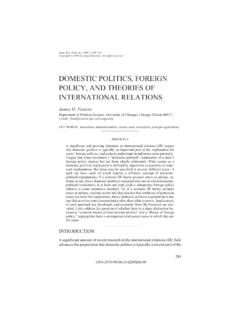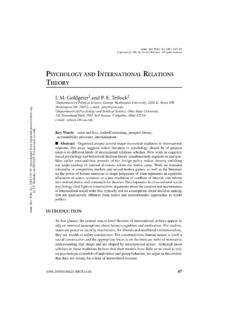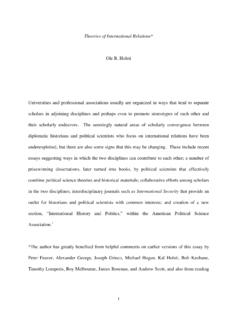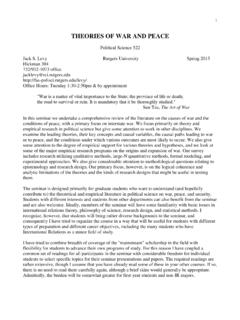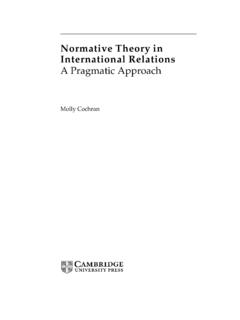Transcription of “The Limitations of Mainstream International …
1 1 The Limitations of Mainstream International relations theories for understanding the Politics of Forced Migration . Amitav Acharya Lecture at Centre for International Studies, Oxford University, 27 October 2008 (preliminary draft only, notes and references incomplete, citation requires prior permission of the author) Let me at the outset thank the organisers of the Refugees in International relations Project at Oxford University for undertaking a very timely and worthwhile project, which addresses a major gap not only in the field of refugee studies or forced migration studies (FMS) , but also has a potential to address some critical gaps in International relations theory. I am not a scholar of forced migration/refugee studies. But as a student of International relations with a special interest in extending the concerns and frontiers of IR theory, I am really delighted to have this opportunity to reflect on the topic of forced migration and how it fits within our available frameworks of IR theory.
2 I have been asked to speak about The Limitations of Mainstream International relations theories for understanding the Politics of Forced Migration . In a sense, I think that Mainstream IR theories (MIRTs) are actually excellent tools for understanding the politics of forced migration. The working and the deficiencies of the current International governance regimes for refugees and forced migrants (I use the two terms interchangeably to refer to actors, institutions, principles and practices that are constitute the governance of refugees ad internally displaced persons) is a mirror image of the way MIRTs view the world, and their intellectual roots in the Western dominance of the International system. What the MIRTs do not tell us is how the International forced migration regime should work, not how it actually works. And since, as I will argue below, my understanding of the functions of theory has a normative element, it is here that some of the major deficiencies of MIRTs can be located and discussed.
3 This is a central point of my analysis. I should also point out at the outset that I do have some misgivings about building a bridge between (FMS) and IR theory in general. This is because IR theory can be highly limiting for an academic field that has been evolving in a very transdisciplinary or multidisciplinary manner. Compared to FMS, IR is far less accommodating of perspectives from multiple disciplines, although it has interacted well with economics (for neorealism and liberalism) and sociology (for constructivism). But the meaning, scope and function of theory in IR remain heavily contested and one would not want refugee studies to get infected with these endless and sometimes stifling debates by associating too closely with IR. And as I will argue latter, perhaps IR theory has much more to learn from students of forced migration than vice versa. My presentation proceeds in four parts.
4 First, I will outline what I consider to be the MIRTs, namely realism, liberalism and more controversially, constructivism. Aside from analysing their core assumptions, I will mention their individual deficiencies in dealing with the challenge of forced migration. Second, I will identify some common biases that run through all the MIRTs which greatly limit their ability to deal with the politics of forced migration. Third, I will identify two recent attempts to redefine and broaden MIRTs which have particular relevance for forced migration 2studies, because they have permeated and redefined the role of the UNHCR, the premier agency dealing with forced migration. These are firstly, human security, a concept which fits largely but not exclusively within the liberal theoretical paradigm in IR, and secondly, securitisation theory, which is mainly, and again not exclusively, a constructivist contribution.
5 Finally, I will highlight a few areas in which IR theory in general and FMS can meaningfully interact with each other. A word about the meaning of theory is necessary here. Considerable debate has taken place over what theory is and what its functions are. Without spending too much time discussing these debates, let me outline briefly four major functions in terms of which I understand theory of International relations . The first function of theory is description and in a related vein, understanding . Theory describes reality, or presents a mental picture of the world whether or not one accepts it as objective reality. Some people, such as European scholars of IR, would accept that theory is mainly a systematic way of organising our facts and marshalling evidence in support of our arguments about International relations . The second function of theory is explanation; in this sense, theory offers ways of making causal linkages between different sets of phenomena.
6 This is very much an American preoccupation just as the first function of theory is more associated with European scholarship on IR. The third function of theory is prediction, although not everyone will agree that this is a legitimate or desirable function of theory. But most theories do carry a predictive element or at least predictions can be deduced from them. Finally, theory in International relations is often about transformation. This is the normative function of IR theory; it s supposed to deal with the question not just of what is, but also what ought to be. Again, while not everyone agrees whether theory should be normative, there is a strong and longstanding tradition of thinking normatively in IR theory which cannot be simply wished away. In this paper, I will evaluate wherever possible and appropriate, the three Mainstream theories of IR in terms of their descriptive, explanatory, predictive and normative claims, although the emphasis will be on the first and the last of these.
7 I would also assume and draw a strong link between theory and policy. Theory, Mainstream of otherwise, cannot be divorced from the realm of policy and practice. The relationship can be conceptualised as a two-way process. The initial formulation of, and revisions to, IR theory by academics do follow developments in the real world, including major and transformational developments such as the beginning or the end of the Cold War. At the same time, policy-makers always carry a mental template of conceptual understanding and assumptions about how the world works, based on their own education, understanding and experience, which informs their policy judgements and decisions. These assumptions often correspond, although not neatly, to those of IR theories . In these cases, theory becomes policy by providing the dominant ideology of the ruling elite and shaping the thinking and approach of the major International institutions.
8 This relationship calls for particular attention to the normative elements of theory, which especially carry policy relevance. In assessing the relevance of IR theories in understanding the politics of forced migration therefore, I assume that these theories not just inform policy, but are also made and remade by politics and policy. Hence to a considerable extent, while passing judgements on IR theories , I also pass judgements on their institutional and policy manifestations, including the role of International agencies like the UNHCR. It is in this sense that I make one of my central arguments: the close correspondence between the biases of Mainstream IR theories and the deficiencies of the prevailing International forced migration regime. 3 Realism, Liberalism and Constructivism Let me now turn to the Mainstream theories of International relations , including a brief examination of their major assumptions and arguments.
9 There is little disagreement in the field of IR that realism and liberalism are the two major Mainstream theories of IR. Realism: Realism is perhaps the oldest and still the dominant form of IR theory. Its main arguments are well known and need only brief mention here. First, states are the main actors in International relations . Second, International system is anarchic in the sense that there is no higher authority above the state. Third, national interest often defined as power, is the basis for state behaviour. Fourth, conflict sometimes leading to war is a natural and persistent feature of International relations . If war can be avoided, albeit temporarily, it is because of the tendency of states to balance each other. Fifth, International institutions are marginal to the game of International relations ; they are wholly subservient to great power whim and manipulation and are effective only as far as great powers allow them to be.
10 There are also well-known variations within realism. The structural realism of Waltz holds that anarchy and the distribution of power are the major determinants of state behaviour, thereby challenging classical realism which takes human nature to be the main causal variable of International relations . There is also the broad disagreement between offensive and defensive realists. Offensive realists like John Mearsheimer argue that states are power-maximisers, who, especially when they happen to be rising and aspiring great powers, are apt to pursue a expansionist course and thereby invite clash with status quo powers in the International system. Defensive realists like Jack Snyder and Robert Jervis disagree with this view; for them states are likely to remain content with their security achieved through a balance of power system. The causal and predictive elements of realism have centered on arguments, following a Waltizian logic, that the end of the Cold War would not lead to stable peace, but unleash new forms of inter-state conflict and great power competition that are characteristic of multipolar systems.

